A new version of the open-source virtualization management platform Proxmox VE has been released. The new version based on Debian Buster (10.2) with Linux kernel 5.3 and includes QEMU 4.1.1, LXC 3.2, Ceph Nautilus (14.2.4.1), Corosync 3.0, and ZFS 0.8.2.
VIENNA, Austria – December 04, 2019 – Proxmox Server Solutions GmbH, developer of the open-source virtualization management platform Proxmox VE, today released version 6.1. The new version of Proxmox VE is based on Debian Buster (10.2) and a 5.3 Linux kernel and includes updates to the latest versions of the leading open-source technologies for virtual environments like QEMU 4.1.1, LXC 3.2, Ceph Nautilus (14.2.4.1), Corosync 3.0, and ZFS 0.8.2.
Proxmox VE 6.1 comes with several new features, improved cluster stability, a HA migrate option, notable bug fixes, and has become even more comfortably useable as many features for management tasks have been added to the web interface.
What’s new in Proxmox VE 6.1
- Container: Proxmox VE 6.1 brings new features for containers such as pending changes. It is now possible to make changes to running containers and they will be applied after the following reboot. A reboot of a running container is either possible via the GUI, the API, or the command line interface. Hot plugging of mount points are now enabled by using the new mount API available with Linux Kernel 5.3.
- Ease of management and improved access security: The Proxmox design team has added countless new features to the web-based user interface.
- If the package ifupdown2 of the Debian network interface manager is installed, it’s now possible to change the network configuration and reload it in the Proxmox web interface without a reboot.
- Added configuration options including settings for Universal 2nd Factor (U2F) or editing the cluster-wide bandwidth limit for the traffic types migration, backup/restore, cloning, disk-move are available.
- Improvements to the two-factor authentication allowing to use a hardware-based TOTP key.
- Mobile interface: In the mobile interface a login for TOTP-based two-factor authentication enabled user accounts has been implemented.
- The scale mode of noVNC can be changed in "My Settings".
- A new "Run now" button for cluster-wide backup jobs has been implemented.
- SPICE improvements: For a seamless remote access to virtual machines, a couple of SPICE enhancements are now available in the GUI. With Proxmox VE version 6.1 audio devices can be added without the need to edit the configuration file. Also video streaming can be enabled, and sharing folders between the SPICE client and a VM is possible (although still experimental). The SPICE USB device now supports USB3 (if using Qemu 4.1 or greater).
- Backup/Restore: VMs with IOThreads enabled can be backed up with Proxmox VE 6.1. Additionally, administrators can run scheduled backup jobs manually from the Datacenter in the GUI.
- Improvements to the HA stack:
- New 'migrate' shutdown policy: If the new migrate option is enabled, running services are migrated to another node on shutdown. As soon as the node comes back and the services were not manually moved to another node in the meantime, the services will move back.
- New 'crm-command stop': Shuts down a VM/container with the specified timeout and performs a hard stop if the timeout is 0. A VM or container stop command will be redirected to this new crm-command.
Other Notable Changes in Proxmox VE 6.1
- For QEMU, the new 'reboot' API call enables to apply pending changes without having to wait for the guest to shutdown before starting it again. In Proxmox VE 6.1, PCI(e) passthrough now supports up to 16 PCI(e) devices.
- Virtual guests can enable 'tags' in the guest configuration. This meta-information is very useful for configuration management with Ansible, Puppet, SaltStack, etc..
- Software-defined Storage: In the Proxmox storage backend, all features offered by newer kernels with Ceph and KRBD are supported with version 6.1. For storing raw disk images, the .img file format is additionally allowed as an alternative to ISO images (.iso). The configuration of non-default 'mountpoint' properties for ZFS are allowed.
- Improved certificate handling including compatibility for latest browsers. The lifetime of newly generated certificates has been reduced from ten to two years.
- Firewall: Added support for 'raw' tables and use them to allow users to enable and configure Synflood-Attack protections.
Notable Bugfixes
The QEMU monitor timeout issue, which prevented successful backups in certain configurations, has been fixed. A number of bugs have been identified and fixed upstream in cooperation with corosync and kronosnet.
Availability
Proxmox VE 6.1 is available for download at https://www.proxmox.com/downloads
Checklist tool ‘pve5to6’
Users can check their installation before, during and after the upgrade process with the checklist tool ‘pve5to6’. It’s included in the latest Proxmox VE 5.4 packages and will provide hints and warnings about potential issues.
Upgrade from Proxmox VE 5.4 to 6.0
Distribution upgrades from Proxmox VE 5.4 to 6.1 should follow the detailed instructions as a major version of Corosync is present (2.x to 3.x). There is a three-step upgrade path for clusters where users first need to upgrade to Corosync 3, then upgrade to Proxmox VE 6.1, and finally upgrade the Ceph cluster from Ceph Luminous to Nautilus. For detailed upgrade guides please see https://pve.proxmox.com/wiki/Upgrade_from_5.x_to_6.0 and https://pve.proxmox.com/wiki/Ceph_Luminous_to_Nautilus
Distribution upgrades from a beta version of Proxmox VE 6.1 is possible with apt. It’s also possible to install Proxmox VE 6.1 on top of Debian Buster.
Proxmox VE is published under the free software license GNU Affero GPL, v3. Enterprise support is available from Proxmox Server Solutions on a subscription basis starting at EUR 79,90 per year and CPU.

